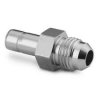I told myself that I was going to leave the engine stock, because the point of a $99 engine is it is cheap...
Well that didn't last long. A trip to the dragstrip on "Minibike Night" has given me the itch. One of the locals just went 7.9x in the 1/8 with a "smallblock", I cannot afford to compete, so it will just be a simple build to wake it up.
What I currently have:
Hemi Predator
Homemade step header
Stock carb - 35 main jet, 20 pilot, stock e-tube
Slipstream Flywheel ~30 deg timing
Governor spring tension increased ~4100 RPM
Knock off TAV2 with increased tension on stock spring (also have 7" driven)
12/54 gear, 15x6 tire

Parts I have collected:
Black Mamba Jr.
26lb springs
Alum retainers and suzuki locks
stock size SS valves w/ lash caps
24mm OKO Flatslide
Solid side cover dowels
Studs for side cover

I don't plan to spin it too high, 7500RPM I guess, especially with the TAV, but talking with some of the guys at the track, I am questioning the BMJr, maybe I should have gone Sr. I was originally planning a ~10:1 build, but I don't mind running race gas, but the Jr might be too short duration for more squeeze. I guess BHP rockers aren't out of the question.
My piston is 0.020" in the hole, but I like the idea of a long rod. I was leaning towards the 3.707 rod with a Wiseco, then turning a dome on the lathe to keep adequate Piston-head with a stock style gasket. That way I could bump the CR, without cutting the head. When would the stock fire ring gasket have trouble sealing?
I then saw NR's billet piston.
Piston, Billet, Domed, GX200 & 212 Predators, .490 Wristpin, 2 ring style
A billet piston is a bit overkill, but it would save me some time, and already has valve reliefs. Russell indicated the dome was ~3cc, that really isn't that much. Should I be concerned about only having 2 rings? Would I have to re-balance with he 3.707 rod and billet piston?
I am going to clean up the head, not hogging it out, just focusing on the port to bowl transition, short turn and guide area.
The easy way would just be to go with the 0.020 rod and deck the head, or leave the piston in the hole and use the thin gasket...but for some reason I feel the need to be different...
Well that didn't last long. A trip to the dragstrip on "Minibike Night" has given me the itch. One of the locals just went 7.9x in the 1/8 with a "smallblock", I cannot afford to compete, so it will just be a simple build to wake it up.
What I currently have:
Hemi Predator
Homemade step header
Stock carb - 35 main jet, 20 pilot, stock e-tube
Slipstream Flywheel ~30 deg timing
Governor spring tension increased ~4100 RPM
Knock off TAV2 with increased tension on stock spring (also have 7" driven)
12/54 gear, 15x6 tire
Parts I have collected:
Black Mamba Jr.
26lb springs
Alum retainers and suzuki locks
stock size SS valves w/ lash caps
24mm OKO Flatslide
Solid side cover dowels
Studs for side cover
I don't plan to spin it too high, 7500RPM I guess, especially with the TAV, but talking with some of the guys at the track, I am questioning the BMJr, maybe I should have gone Sr. I was originally planning a ~10:1 build, but I don't mind running race gas, but the Jr might be too short duration for more squeeze. I guess BHP rockers aren't out of the question.
My piston is 0.020" in the hole, but I like the idea of a long rod. I was leaning towards the 3.707 rod with a Wiseco, then turning a dome on the lathe to keep adequate Piston-head with a stock style gasket. That way I could bump the CR, without cutting the head. When would the stock fire ring gasket have trouble sealing?
I then saw NR's billet piston.
Piston, Billet, Domed, GX200 & 212 Predators, .490 Wristpin, 2 ring style
A billet piston is a bit overkill, but it would save me some time, and already has valve reliefs. Russell indicated the dome was ~3cc, that really isn't that much. Should I be concerned about only having 2 rings? Would I have to re-balance with he 3.707 rod and billet piston?
I am going to clean up the head, not hogging it out, just focusing on the port to bowl transition, short turn and guide area.
The easy way would just be to go with the 0.020 rod and deck the head, or leave the piston in the hole and use the thin gasket...but for some reason I feel the need to be different...










